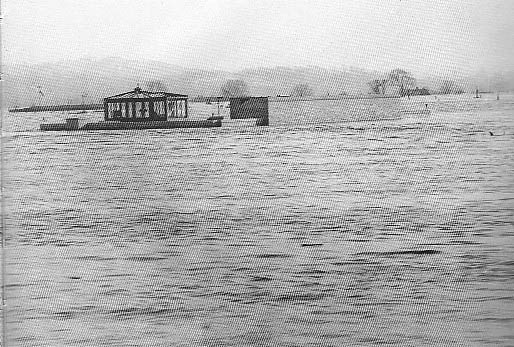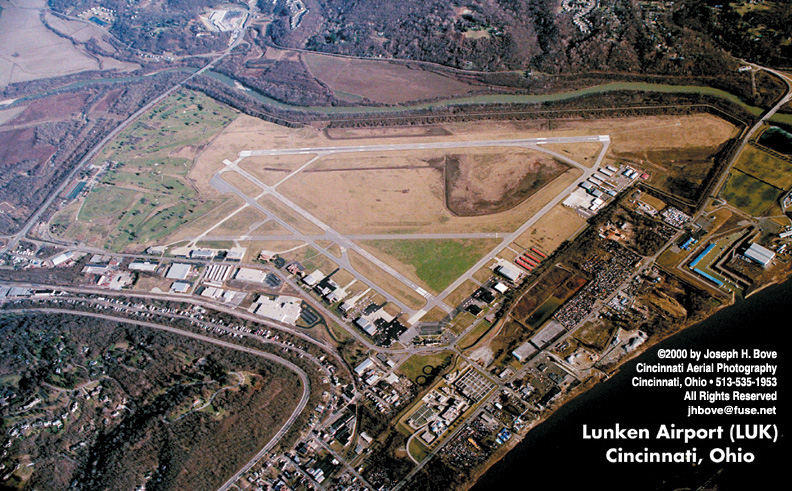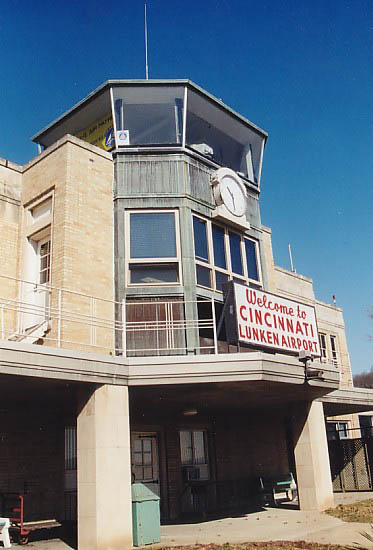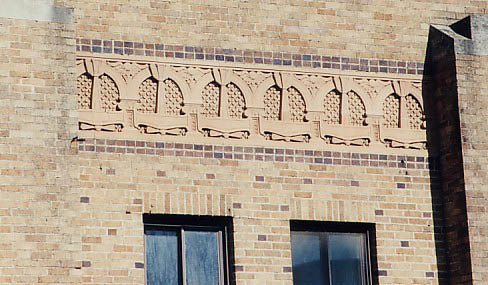
The new tower nearly completely submerged during the 1937 flood.

In the early 1920s, barnstorming pilots made their wayacross the country to earn a living. One such pilot was Dixie Daviswho started a flying business at the corner of Wilmer and BeechmontAve, where the Lunken playfield is now located. This small airfield caughtthe attention of the Grisard Company (partially owned by Eshelby Lunken),which owned Grisard Field in Blue Ash. Mr. Lunken viewed this new airfieldin what was then called the Turkey Bottoms as having more growth potentialand was only four miles from downtown Cincinnati. In December 1925,the Grisard Company dissolved and the Lunken family provided financialbacking to purchase 204 additional acres of land owned by the CincinnatiPolo Club. This airfield then became known as Lunken Airport. Lucrative airmail routes and military hangars for the reserve squadronat Blue Ash airport were moved to Lunken Airport. The old hangars(Hangar 6) at the east end of the field are rumored to have come from historicMcCook Field in Dayton, Ohio. This move also helped secure Federal Fundingand stimulated additioinal growth.
In 1925, the Embry Riddle Company organized at Lunkenand provided airline, air mail service, and flight raining and became thefirst government approved flight school in the United States. EmbryRiddle later went on to become Embry Riddle Aeronautical University inFlorida. In 1928, the Cincinnati of City passed a bond issue allowingpurchase of an additional 870 acres and took assignment of a perpetuallease of the airport from the Lunken family. The airfield was now operatedby the City of Cincinnati, and long-term plans envisioned Lunken as thecity's main airport. Airlines began operation out of the airportin 1925. In 1929, brick aircraft hangars were built along the southside of the airfield in art deco style. Also in 1929, metal monoplanesbuilt by the Metal Aircraft Corporation, called the Flamingo, were builtnear the airfield. Of 21 built, one survives in South America today.The Aeronca Aircraft Company also built aircraft until 1940 in Hangar #4.
The early beginnings of American Airlines also startedat Lunken in 1929 with passenger flights to Chicago. Lunken soonbecame the center of aviation in Cincinnati with increasing airline trafficand the periodic appearance of famous celebrities. 1929 saw 29,059 flightsand 8,528-recorded passengers making their way through Lunken Airport.
In 1936 construction began on the distinctive terminalbuilding still in use today. But in early 1937 the greatest floodin recorded history spilled over the levee and inundated the entire airport,including the half-finished terminal. The flood water levels reachedto the top of the terminal building's control tower. A single black brickon the tower facing the airfield marks the high water mark to this day.

The new tower nearly completely submerged during the 1937 flood.
The airfield's location in a flood plain was one geographicaldisadvantage and heavy fog and surrounding hilltops were others. All these factors put a damper on serious thought to expand Lunken airportinto a major airport. Some civic leaders looked to the Blue Ash airfieldlocation as the site of Cincinnati's major airport. Politicians andcivic leaders engaged in internal feuding trying to decide where the mainCincinnati airport should be located. Meanwhile, politicians in NorthernKentucky, sensing a great opportunity at hand, met with Federal authoritiesand secured Federal funding to build an airfield in Northern Kentucky. While Northern Kentucky officials rolled forward with their airport plans,Cincinnati officials were deadlocked in disagreement that lasted for decades.

The main terminal building
In 1946, the major airlines began to pull out of Lunkenand started operations at the "Greater Cincinnati Airport" located in NorthernKentucky. Lunken continued expansion with corporations establishingtheir flight operations out of Lunken in 1951. To date, most CincinnatiCorporations base their flight departments at Lunken. Throughout the years,it became known as a "reliever" airport, handling most general aviationtraffic operations in the Cincinnati area. Admittedly, a small airplaneoperating at CVG is like riding a bicycle on I-75. Lunken also had itsfair share of celebrities over the years including The Beatles and mostrecent US presidents.
Lunken airport is presently an 2000-acre airfield forgeneral and corporate aviation, and attempts are made to bring in regionalairlines and increase size limits for larger aircraft to land at the airport. As encroaching suburbs started complaining about noise, the airport wasand is confronted with many battles with the City of Cincinnati and specialinterest groups for funding and expansion that continue to this day. Expensive homes are still being built on the hills directly facing theairport providing more and more property owners who litigate for toughernoise restrictions and less flight activity at the airport. Unfortunately,Lunken Airport is caught in the middle of a tug of war between hostilesurrounding communities and a City Council which seems not to act in theairport's best interest.

Detail of the main terminal building [LarryStulz photo]
Other interesting facts about Lunken:
The original course of the Little Miami River snaked throughthe middle of the present Lunken airfield. One can see traces ofthe old riverbed in aerial photos of the field. The Little Miami was reroutedto the east of the field and is separated from the airfield by a massivedike system. Lunken bike trail is a paved roadway/sidewalk that completelyencircles the airfield for 2.5 miles and is used extensively by walkers,runners and bicyclists.
The airfield literally sits atop the lands that were occupiedby the first settlers in this region in 1788. The small settlementof Columbia was established and the original cemetery is located acrossthe street from the airport on Wilmer Avenue. The settlement latermoved downriver to Tusculum and later, further down to the location thatbecame the City of Cincinnati.
Air operations at Lunken Airport can be monitored by scannerfrequencies 118.7, 121.9, 121.0.
For more statistics on Lunken Airport, ClickHere
1. Cincinnati/NorthernKentucky International Airport
2. LunkenAirport
3. BlueAsh Airport